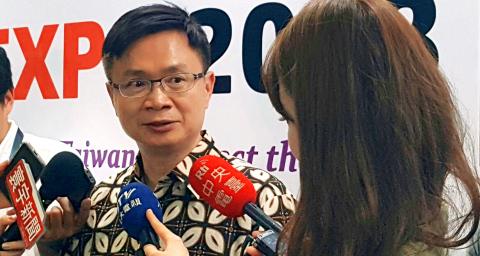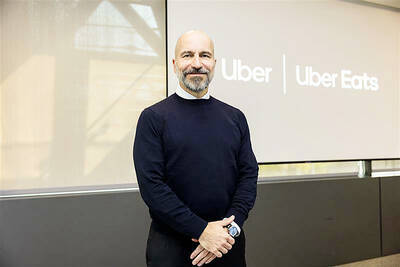Taipei Times (TT): Some Taiwanese companies have had roots in Indonesia for more than 30 years, including those textile manufacturers that seek production bases with lower labor costs. From your observations, are there any emerging opportunities for Taiwanese companies to explore in Indonesia?
James Huang (黃志芳): Taiwan last year invested a total of US$397 million in Indonesia, indicating a 166 percent jump from US$149 million in 2016. The figure shows that a lot of Taiwanese companies have expressed interests in tapping into the Indonesian market.
There is a noticeable shift in business models. In the past, most Taiwanese export-reliant firms that chose Indonesia as their production base sold their products to overseas customers. However, in recent years, I have found that some companies have shifted their target to Indonesia’s domestic market, such as tire maker Cheng Shin Rubber Industry Co (正新橡膠).

Photo: Kuo Chia-erh, Taipei Times
Apart from suppliers in traditional manufacturing industries, many services and “smart” solution providers have been trying to enter the Indonesian market, eyeing growing demand backed by the country’s strong economic growth.
The trend echoes the government’s New Southbound Policy, which encourages Taiwanese businesspeople to grasp opportunities in the domestic demand markets of our Southeast Asian neighbors.
TT: How can TAITRA help Taiwanese companies sell their products in the Indonesian market?
Huang: We launched the Taiwan Halal Center in Taipei in April last year, with the aim of promoting halal-certified products. Our colleagues working at overseas branches also help Taiwanese companies obtain related certification to export their products to Muslim markets.
It is so important for us to continue promoting halal certification, considering regulatory changes regarding Indonesia’s food products. From next year, all goods distributed in Indonesia must be clearly labeled as halal-certified or non-halal.
TT: TAITRA held its first-ever Taiwan Expo in Indonesia last year. What were the features of this year’s Taiwan Expo in Jakarta?
Huang: The role of the Taiwan Expo is to raise awareness about the New Southbound Policy and facilitate collaborations through matchmaking events. We introduce our best technologies and products to customers in different markets.
The size of this year’s Taiwan Expo almost doubled from last year. For this year’s exhibition, we invited 230 Taiwanese firms from 10 industries, ranging from machinery, home appliances and cosmetics to food and beverages. They used 280 booths to exhibit more than 4,500 products and services at the three-day event.
Aside from new booths and pavilions, we also organized a special team comprising officials from eight Taiwanese banks to investigate Indonesia’s financial market. There is still much room for the development of the banking industry, given that country’s population is nearly 250 million.
The Taiwan Expo last year generated orders worth about US$49 million in Jakarta and we expect the figure to grow by at least 20 percent annually this year.
TT: What are TAITRA’s promotion plans for other Asian countries this year?
Huang: We are to hold a Taiwan Expo in New Delhi for the first time next month. India is a rapidly growing economy with a total population of 1.3 billion people and its economic growth is even faster than China and ASEAN members. The market is worth exploring further.
The India event aims to be in line with the Indian government’s latest economic policies. The government has been pushing several programs that boost economic development, such as Make in India, Green India and Digital India. The size of India’s digital economy, for instance, is expected to reach US$1 trillion in the foreseeable future.
We hope to meet rising demand in those sectors, since Taiwan is globally competitive in the manufacturing, green energy and telecommunication industries. TAITRA will also hold a Taiwan Expo in Vietnam, Thailand and Malaysia this year. Each expo will be themed to suit each country.

CHIP RACE: Three years of overbroad export controls drove foreign competitors to pursue their own AI chips, and ‘cost US taxpayers billions of dollars,’ Nvidia said China has figured out the US strategy for allowing it to buy Nvidia Corp’s H200s and is rejecting the artificial intelligence (AI) chip in favor of domestically developed semiconductors, White House AI adviser David Sacks said, citing news reports. US President Donald Trump on Monday said that he would allow shipments of Nvidia’s H200 chips to China, part of an administration effort backed by Sacks to challenge Chinese tech champions such as Huawei Technologies Co (華為) by bringing US competition to their home market. On Friday, Sacks signaled that he was uncertain about whether that approach would work. “They’re rejecting our chips,” Sacks

NATIONAL SECURITY: Intel’s testing of ACM tools despite US government control ‘highlights egregious gaps in US technology protection policies,’ a former official said Chipmaker Intel Corp has tested chipmaking tools this year from a toolmaker with deep roots in China and two overseas units that were targeted by US sanctions, according to two sources with direct knowledge of the matter. Intel, which fended off calls for its CEO’s resignation from US President Donald Trump in August over his alleged ties to China, got the tools from ACM Research Inc, a Fremont, California-based producer of chipmaking equipment. Two of ACM’s units, based in Shanghai and South Korea, were among a number of firms barred last year from receiving US technology over claims they have

It is challenging to build infrastructure in much of Europe. Constrained budgets and polarized politics tend to undermine long-term projects, forcing officials to react to emergencies rather than plan for the future. Not in Austria. Today, the country is to officially open its Koralmbahn tunnel, the 5.9 billion euro (US$6.9 billion) centerpiece of a groundbreaking new railway that will eventually run from Poland’s Baltic coast to the Adriatic Sea, transforming travel within Austria and positioning the Alpine nation at the forefront of logistics in Europe. “It is Austria’s biggest socio-economic experiment in over a century,” said Eric Kirschner, an economist at Graz-based Joanneum

OPTION: Uber said it could provide higher pay for batch trips, if incentives for batching is not removed entirely, as the latter would force it to pass on the costs to consumers Uber Technologies Inc yesterday warned that proposed restrictions on batching orders and minimum wages could prompt a NT$20 delivery fee increase in Taiwan, as lower efficiency would drive up costs. Uber CEO Dara Khosrowshahi made the remarks yesterday during his visit to Taiwan. He is on a multileg trip to the region, which includes stops in South Korea and Japan. His visit coincided the release last month of the Ministry of Labor’s draft bill on the delivery sector, which aims to safeguard delivery workers’ rights and improve their welfare. The ministry set the minimum pay for local food delivery drivers at